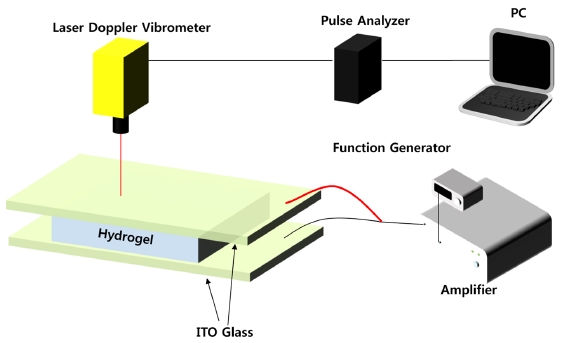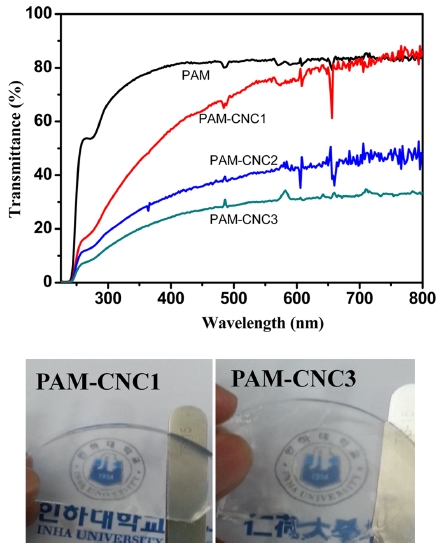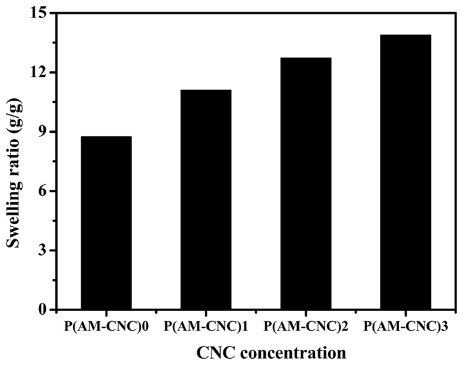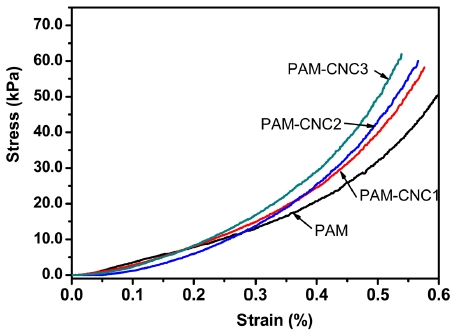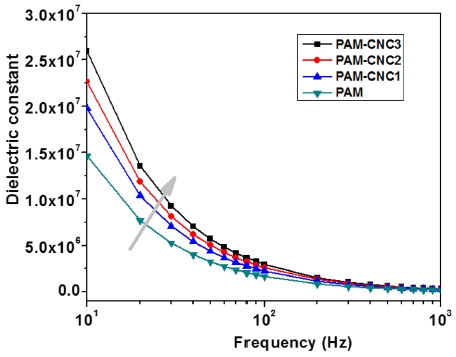
Optical and Electro-Active Properties of Polyacrylamide/CNC Composite Hydrogels
Copyright © The Korean Society for Precision Engineering
This is an Open-Access article distributed under the terms of the Creative Commons Attribution Non-Commercial License (http://creativecommons.org/licenses/by-nc/3.0) which permits unrestricted non-commercial use, distribution, and reproduction in any medium, provided the original work is properly cited.
Abstract
Polyacrylamide (PAM) was used for matrix material to fabricate composite hydrogels reinforced with natural cellulose nanocrystal (CNC). Invoking in situ free-radical polymerization with different concentration of cellulose nanocrystal, polyacrylamide hydrogels were fabricated. The chemical structure, compression strength, morphology and dielectric properties of the composite hydrogels were investigated. The CNC played a role as a reinforcing filler and a multifunctional cross-linker in the hydrogel. The elastic modulus and dielectric property of the composite hydrogels increased as increasing the CNC concentration. The electrical actuation test of the PAM/CNC hydrogel shows its possibility for soft electro-active materials for active lens.
Keywords:
Polyacrylamide, Cellulose nanocrystal, Hydrogel, Dielectric property, Electro-active키워드:
폴리아크릴아미드, 셀룰로오스 나노결정, 하이드로젤, 유전특성, 전기활성1. Introduction
Polymers which undergo shape change in response to various environmental stimuli can convert physical or chemical energy into mechanical behavior directly. Some polymers such as polypyrrole, polyaniline, cellulose have been reported this kind of stimuli-responsive materials, so called electro-active polymers. Due to this phenomenon, those materials can be applied to produce soft actuators and artificial muscles.1,2 Most of them exhibit dimensional changes in an electrolyte solution or in solid-state like film, while few reports have been investigated on hydrogel state.
Cellulose, most abundant natural and renewable polysaccharides, is a classical highly-biocompatible material. Cellulose is usually biosynthesized by diverse organisms and deposited in a continuous elementary micro fibrils, which can be changed from 100 nm to several μm in length and can be 5-10 nm in diameter depending on the source of cellulose. The elementary cellulose fibrils are made up of amorphous and crystals parts. The crystalline parts are separated by amorphous parts and existed in rod-shaped cellulose nanocrystals (CNCs) with dimension of about several to 20 nm in diameter and lengths up to 2 um. The cellulose nanocrystals can be obtained by hydrolysis under acidic controlled conditions. Hydrolysis consists in destruction of the amorphous parts surrounding and between the cellulose microfibrils, while the crystalline segments remain intact. Finally, the obtained colloidal particles commonly referred to as CNCs.3,4 Due to some properties such as chemical resistance, high mechanical strength, high aspect ratio, biocompatibility, high surface area, and excellent properties of surface derivatization, CNCs have attracted lots of attention for the reinforcement of polymer matrix.5 However, a polymer hydrogel, in other words, a cross-linked polymer network reinforced with CNCs has not been studied enough. Considering excellent dispersion of CNCs in water, the molding, fabrication, and application of hydrogels containing CNCs have many advantages compared with other solid nanocomposites. It also shows good electro-active response applicable for sensors, actuators and biomedical devices.4,6
Polyacrylamide (PAM), one of the most commonly available polymers for hydrogels, can be defined as lightly cross-linked polymer. It can swell dramatically in the presence of water but insoluble due to their non-toxic and biologically inert long chain lengths. It also has a capacity for preserving its shape and mechanical strength and for conveniently adjusting its mechanical, chemical and biophysical properties.7 Hence, PAM hydrogels have various applications in agriculture,8 drilling fluids,9 tissue engineering,10 and waste treatments. Up to now, considerable studies have been conducted to improve mechanical and chemical properties of PAM hydrogels via adding nanofillers such as polymer nanoparticles, inorganic clay, and metal nanoparticles11 into PAM-based matrix. PAM can sense its physical, chemical and biological environment changes and respond to external stimuli in a controllable way. PAM can show abrupt and vast volume changes in response to various stimuli from a surrounding environment and can be driven by electric field. For the past several decades, PAM hydrogel has been developed very fast in this area.12-14
In addition, based on the excellent optical transparency, PAM can be applied for active lens.
This paper aims at developing PAM based electro-active hydrogel that can be applied for active lens. This electro-active hydrogel should be able to change volume in the presence of electric field with maintaining optical transparency for lens application. We introduce PAM hydrogel as the base matrix and CNCs as the filler. By adding CNC filler in PAM matrix, its dielectric property can be drastically increased without sacrificing the optical transparency of PAM. Fig. 1 shows the synthesis scheme of PAM/CNC composite hydrogels. The chemical structure, morphology and structural property of the PAM/CNC composite hydrogels are determined with Fourier transform infrared (FTIR) spectroscopy and scanning electron microscopy (SEM). To investigate the electro-active behavior of CNC in PAM hydrogels, an electric field was applied across its thickness. The electro-active behavior and its mechanism are also explained.
2. Experimental
2.1 Materials
Acrylamide (AM), Ammonium persulfate (APS), N, N’-Methylenebisacrylamide (MBAAm), concentrated sulfuric acid (H2SO4), deionized (DI)-water, N, N, N′, N′-Tetramethylethylenediamine (TEMED), Sodium hydroxide (NaOH), Cotton pulp powder. We used all chemicals without any further purification as received. DI-water was used in the whole process.
2.2 Preparation of CNC
The CNC was prepared by hydrolysis process. We put pure cotton pulp (20.0 g) in 60 wt% H2SO4 aqueous solution (200 mL) under mechanical stirring (2 h, 200 rpm) at 50°C. Prior to acid hydrolysis, an alkaline treatment was also made on the cotton pulp to remove non-cellulosic components. The hydrolysis process resulted in a suspension, which was further centrifuged successively with DI water to obtain neutrality, followed by homogenization (11000 rpm, 10 min) and dialysis. Finally, the CNC suspension was obtained.
2.3 Synthesis of PAM/CNC Composite Hydrogels
PAM hydrogels were synthesized by the standard free radiation copolymerization method. An aqueous solution of TEMED was prepared and used as a cross-linker in the polymerization process.15 Also, ammonium persulfate solution and MBAAm were prepared and used as initiator and accelerator, respectively. The monomer solution was stirred with a magnetic bar on a stirring plate until all reactants were completely dissolved. After that, CNC aqueous solution was added to fabricate the PAM/CNC hydrogel. Following this, MBAAm was added. After stirring 10 mins, TEMED and APS were added to initiate polymerization at the same time. At last, it was cast into a mold. The synthesized gel was dried at oven. After that, dried gel was immersed in DI-water for three days, with water changes three times to remove any unreacted monomers. Finally, PAM/CNC hydrogel can be obtained. Table 1 shows different composition of PAM/CNC hydrogels.
3. Characterizations
By using VERTEX-80 FT-IR spectrometer (Bruker), we recorded FTIR spectra of CNC, PAM and PAM/CNC hydrogel samples at room temperature. We prepared the test specimen using the KBr disc method and analyzed the specimen within range of 400-4000 cm-1. FE-TEM micrographs were taken by using a TEM (JEOL, JEM 2100F). We took FE-SEM images of the specimen with the field emission scanning electron microscope (FE-SEM, Hitachi S-4300) to study the sample morphology. Samples were prepared by a freeze-dry method. Before putting in a freeze-dry machine, it was frozen by liquid nitrogen and we coated the samples with platinum by using a sputter before the SEM observation. Optical property of the samples was studied by using UV-visible spectrophotometer (HP 8452A). The optical transmittance spectra of the films were recorded within the range of 200-800 nm wavelengths.
Mechanical properties of the samples were tested by using universal testing machine according to ASTM D-882-97. We put the samples between the two parallel plates and the upper plate pressed the sample. Test was performed under room temperature with the compression rate of 0.005 mm/s. Dielectric constant and dielectric loss of specimen were measured using the HP 4284A LCR meter which has frequency range of 20 Hz-1 MHz at room temperature.
To investigate the electro-active behavior of PAM/CNC composite hydrogels, electrical actuation test was performed. The actuation test was conducted by using a laser Doppler vibrometer (LDV, OMETRON VS-100) which measured displacement. Input voltage was applied and amplified by using function generator (33220A, Agilent) and high voltage amplifier (HP 8452A, TREK). Pulse analyzer and Personal computer (PC) were used for collecting displacement signal from LDV. Before conducting actuation test, the desired hydrogels were equilibrated in the DI water for 24 h. The thickness of the hydrogel was around 4 mm. After reaching the equilibration, the swollen hydrogels were located between two ITO glasses as electrodes which applied electric signal. Fig. 2 illustrates the experimental setup for actuation test.
4. Results and Discussion
4.1 Sample Morphology
Fig. 3(a) shows the AFM image of isolated CNCs. They exhibit rod like nanostructure with 25-40 nm diameter. For AFM observation, the isolated CNCs were coated on a silicon wafer on which oxidized using piranha solution. Compact network structure of CNCs shows the internal bonding present in it. Fig. 3(b) shows the high resolution TEM image of the CNCs. The diameter of CNC has broad range of distribution but the length of great part of the ‘rod-like’ CNCs is within the range 250-380 nm.
We investigated the composite’s morphology by the SEM images of polyacrylamide with CNCs. Fig. 4 illustrates the SEM images of a polyacrylamide/CNC hydrogel after freeze drying method. The nanocomposite hydrogels with CNC loadings exhibit uniform dispersion of CNCs within the polyacrylamide matrix, and also uniform pore structure can be observed in the SEM images.
4.2 UV-Transmittance, FTIR and Swelling Index
Fig. 5 illustrates the UV-visible spectra of PAM and PAM/CNC composite hydrogels. The PAM hydrogel is known to be a transparent optical hydrogel as it shows 80% transmittance (at 480 nm). The transmittance increases with the wavelength and saturates beyond 400 nm within visible wavelength region. This observation hydrogels, in which CNCs are well dispersed in the composite hydrogels. However, as increasing the concentration of CNCs, its transparency of composite hydrogel decreases. There is threshold of CNC concentration in the transparency of the composite hydrogels and 1 wt% of CNC concentration is suggested for better transparency.
Fig. 6 represents FTIR spectra of pure PAM, CNC and PAM-CNC3 composite hydrogel. The spectrum of pure PAM shows characteristic peaks at 3390, 3193, 1620 cm-1, attributed to the CONH2 group. The PAM–CNC3 shows characteristic peaks at 1130 and 1062 cm-1 attributed to C-O bond. This indicates that C-O bond is made between PAM and CNC.
The swelling ratio of the PAM and PAM/CNC composite hydrogels swelled in DI-water was calculated using Eq. (1) and results are shown in Fig. 7
| (1) |
where W2 and W1 are a weights of the sample after and before swelling. When CNCs were dispersed in PAM hydrogels, significant changes in swelling ratio were observed. Structural characterization result indicates that the CNCs are strongly interacted with the polyacrylamide matrix through hydrogen bonding.
Hydrogels can undergo large reversible deformations in response to water interaction.
4.3 Mechanical, Dielectric and Electro-Active Properties
We investigated the mechanical compression properties of PAM-CNC composite hydrogels with three different concentrations, PAM-CNC1, PAM-CNC2, PAM-CNC3, as the stress-strain curves shown in the Fig. 8. The results show the CNC addition in the PAM hydrogel improves its mechanical property. Compared with the pure PAM hydrogel, PAM-CNC3 composite hydrogel exhibits significant advance in Young’s modulus as value increases 0.4, 0.48, 0.55 and 0.68 GPa for pure PAM, PAM-CNC1, PAM-CNC2 and PAM-CNC3, respectively. The high modulus is associated with the formation of multifunctional physical cross-links of CNCs with polyacrylamide. Due to strong interaction of hydroxyl groups on the surface of CNCs, they tend to have self-association, which is favorable for a formation of load-bearing percolating networks inside of the host polymer matrix.
Dielectric properties of the composite hydrogels are important to understand electro-active behavior of the hydrogels. Dielectric constant, ε' of the samples was measured within 10 Hz - 1 kHz frequency band, at 25°C, 25% relative humidity, and the results are shown in Fig. 9. When the values are compared among PAM and composites, CNC itself has low dielectric constant. This is attributed to a motion of free charge carriers due to charges present on the CNC surface and interfacial polarization effects. Because the charges of CNC surface counteract the charges of PAM chains, this is why the value decreased with the CNC concentration increase.
Electrical actuation test of the samples was performed. Fig. 10 shows the results. 400 V on 2 mm thickness of samples, which corresponds to 0.2 V/μm electrical field strength, was applied to the samples with frequency range of 20-200 Hz. Displacement in the thickness direction of samples was measured by using the LDV sensor. As increasing the actuation frequency, the displacement decreases. Regarding the CNC concentration, PAM-CNC1 exhibited 1400 ppm at 20 Hz and its value increased to 1750 ppm for PAM-CNC2 and decreased to 1050 ppm for PAM-CNC3. There is a trade-off relation between elastic modulus and electro-active behavior associated with dielectric property. Elastic modulus and dielectric property of PAM-CNC composite hydrogels increase with the CNC concentration. As the elastic modulus increases, its stiffness of hydrogels is so stiff that it is hard to deform in the presence of electric field even though dielectric constant increases. Thus, PAM-CNC1 is an optimum concentration of CNC that produces large electro-active strain. The actuation might be associated with electro-static force associated with dielectric property of the soft hydrogels.
5. Conclusion
Polyacrylamide was used as a matrix material to fabricate nanocomposite hydrogel reinforced with natural cellulose nanocrystal. The fabrication process of polyacrylamide hydrogel via in situ free-radical polymerization with different concentration of CNC was reported. The composite hydrogel’s chemical structure, elastic modulus, morphology, optical transparency and dielectric properties were investigated. The CNCs played a role as a reinforcing filler and a multifunctional cross-linker in the hydrogel system. The elastic modulus and dielectric property of the composite hydrogels increased as increasing the CNC concentration in the composite hydrogels. Finally, the actuation test for the composite hydrogels revealed 1750 ppm strain in thickness direction. There is a trade-off relation between elastic modulus and electro-active behavior associated with dielectric property. Thus, PAM-CNC1 was found to be optimum concentration of CNC that produces large electro-active strain. This composite hydrogels are applicable for tunable active lens.
NOMENCLATURE
| ε' : | Dielectric constant |
| W1 : | The weights of the sample before swelling |
| W2 : | The weights of the sample after swelling |
Acknowledgments
This research was supported by National Research Foundation of Korea (No. NRF-2015R1A3A2066301).
REFERENCES
-
Tungkavet, T., Seetapan, N., Pattavarakorn, D., and Sirivat, A., “Electromechanical Properties of Multi-Walled Carbon Nanotube/Gelatin Hydrogel Composites: Effects of Aspect Ratios, Electric Field, and Temperature,” Materials Science and Engineering: C, Vol. 46, pp. 281-289, 2015.
[https://doi.org/10.1016/j.msec.2014.10.068]

-
Kim, K. J. and Tadokoro, S., “Electroactive Polymers for Robotic Applications,” Springer, pp. 121-152, 2007.
[https://doi.org/10.1007/978-1-84628-372-7]

-
Habibi, Y., Lucia, L. A., and Rojas, O. J., “Cellulose Nanocrystals: Chemistry, Self-Assembly, and Applications,” Chemical Reviews, Vol. 110, No. 6, pp. 3479-3500, 2010.
[https://doi.org/10.1021/cr900339w]

-
Gao, X., Sadasivuni, K. K., Kim, H.-C., Min, S.-K., and Kim, J., “Designing pH-Responsive and Dielectric Hydrogels from Cellulose Nanocrystals,” Journal of Chemical Sciences, Vol. 127, No. 6, pp. 1119-1125, 2015.
[https://doi.org/10.1007/s12039-015-0873-3]

-
Lam, E., Male, K. B., Chong, J. H., Leung, A. C., and Luong, J. H., “Applications of Functionalized and Nanoparticle-Modified Nanocrystalline Cellulose,” Trends in Biotechnology, Vol. 30, No. 5, pp. 283-290, 2012.
[https://doi.org/10.1016/j.tibtech.2012.02.001]

-
Fox, J. D., Capadona, J. R., Marasco, P. D., and Rowan, S. J., “Bioinspired Water-Enhanced Mechanical Gradient Nanocomposite Films that Mimic the Architecture and Properties of the Squid Beak,” Journal of the American Chemical Society, Vol. 135, No. 13, pp. 5167-5174, 2013.
[https://doi.org/10.1021/ja4002713]

-
Xiang, Y., Liu, G., Zhang, C., and Liao, J., “Sulfoacetic Acid Modifying Poly (Vinyl Alcohol) Hydrogel and Its Electroresponsive Behavior under DC Electric Field,” Smart Materials and Structures, Vol. 22, No. 1, pp. 1-7, 2012.
[https://doi.org/10.1088/0964-1726/22/1/014009]

-
Sojka, R., Bjorneberg, D., Entry, J., Lentz, R., and Orts, W., “Polyacrylamide in Agriculture and Environmental Land Management,” Advances in Agronomy, Vol. 92, No. 25, pp. 75-162, 2007.
[https://doi.org/10.1016/S0065-2113(04)92002-0]

-
Yao, L. and Krause, S., “Electromechanical Responses of Strong Acid Polymer Gels in DC Electric Fields,” Macromolecules, Vol. 36, No. 6, pp. 2055-2065, 2003.
[https://doi.org/10.1021/ma021326q]

-
Kai, D., Prabhakaran, M. P., Stahl, B., Eblenkamp, M., Wintermantel, E., et al., “Mechanical Properties and in Vitro Behavior of Nanofiber-Hydrogel Composites for Tissue Engineering Applications,” Nanotechnology, Vol. 23, No. 9, pp. 1-10, 2012.
[https://doi.org/10.1088/0957-4484/23/9/095705]

-
Guo, Y.-G., Hu, J.-S., Liang, H.-P., Wan, L.-J., and Bai, C.-L., “Highly Dispersed Metal Nanoparticles in Porous Anodic Alumina Films Prepared by a Breathing Process of Polyacrylamide Hydrogel,” Chemistry of Materials, Vol. 15, No. 22, pp. 4332-4336, 2003.
[https://doi.org/10.1021/cm0343397]

-
Dai, T., Qing, X., Wang, J., Shen, C., and Lu, Y., “Interfacial Polymerization to High-Quality Polyacrylamide/Polyaniline Composite Hydrogels,” Composites Science and Technology, Vol. 70, No. 3, pp. 498-503, 2010.
[https://doi.org/10.1016/j.compscitech.2009.11.027]

-
Guan, T., Ceyssens, F., and Puers, R., “Fabrication and Testing of a Mems Platform for Characterization of Stimuli-Sensitive Hydrogels,” Journal of Micromechanics and Microengineering, Vol. 22, No. 8, pp. 1-9, 2012.
[https://doi.org/10.1088/0960-1317/22/8/087001]

-
Khaleque, T., Abu-Salih, S., Saunders, J., and Moussa, W., “Experimental Methods of Actuation, Characterization and Prototyping of Hydrogels for BioMEMS/NEMS Applications,” Journal of Nanoscience and Nanotechnology, Vol. 11, No. 3, pp. 2470-2479, 2011.
[https://doi.org/10.1166/jnn.2011.3567]

-
Pandey, M., Mohd Amin, M. C. I., Ahmad, N., and Abeer, M. M., “Rapid Synthesis of Superabsorbent Smart-Swelling Bacterial Cellulose/Acrylamide-Based Hydrogels for Drug Delivery,” International Journal of Polymer Science, No. 23, pp. 1-10, 2013.
[https://doi.org/10.1155/2013/905471]



